With 800 + species of plants, over 330 species of birds, and the highest number of rare, threatened or endangered species for its size, Presque Isle offers nature lovers a one-of-a-kind experience.
View: Animal Life | Plant Life
Animal Life
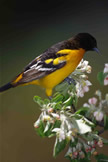 Baltimore Oriole
Baltimore Oriole
(
Icterus galbula)
- Winters in tropical regions, common on Presque Isle in summer months
- Distinctive black hood and brilliant orange plumage in males
- Makes unique hanging basket nests
- Primarily insectivorous, also eats nectar and fruit. Can be attracted to feeders with oranges
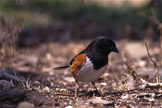 Rufous-sided or Eastern Towhee
Rufous-sided or Eastern Towhee
(Pipilo erythrophthalmus)
- Rummages noisily on ground in leave debris
- Distinctive rufous sides and white outer tail feathers, eye usually red
- Song “drink your tea”
- Diet mostly nuts, seeds, and fruit, some insects
 Great Horned Owl
Great Horned Owl
(Bubo virginianus)
- Very large owl with ear tufts
- Recognizable rust facial disk and white throat
- Fierce bird of prey. Will take rabbits, squirrels, skunks, other owls
 Red-headed Woodpecker
Red-headed Woodpecker
(Melanerpes erythrocephalus)
- Complete red hood, white belly, and black wings
- Diet nuts, seeds, some insects and fruit
- Hide nuts and seeds in tree crevices
- Often driven from nest cavities by European Starlings
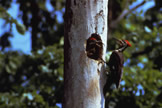 Pileated Woodpecker
Pileated Woodpecker
(Dryocopus pileatus)
- Large, crow-sized bird with brilliant red crest; second in size to nearly extinct Ivory-billed
- Distinctive holes are oblong, somewhat rectangular
- Its staple food consists of carpenter ants. Excavates cavities, then uses long, sticky tongue to reach carpenter ant burrows in fallen timber. Also eats some fruit and nuts.
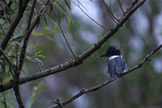 Belted Kingfish
Belted Kingfish
(Ceryle alcyon)
- Large slate-blue bird with big head and impressive crest
- Hovers over water before plunging head first to catch fish
- Diet mostly fish, some amphibians and reptiles
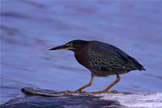 Green Heron
Green Heron
(Butorides virescens)
- Crow-sized wading bird with blue-green back, chestnut neck, and yellow-orange legs
- Diet mostly aquatic invertebrates, some fish
- Known to use bait to attract fish before spearing them with its saber-like bill
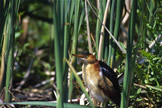 Least Bittern
Least Bittern
(Ixobrychus exilis)
- Buff face and neck, black cap and back
- Very small wading bird
- Secretive, climbs and straddles reeds, seldom flies
- Diet mostly aquatic invertebrates, some fish, amphibians, and reptiles
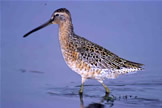 Short-billed Dowitcher
Short-billed Dowitcher
(Limnodromus griseus)
- Snipe-like wading bird
- Distinguished from long-billed dowitcher by white undersides
- Uses long bill to probe sand in rapid up-and-down movements like sewing machine
- Diet mainly marine worms, snails, tiny crustaceans, and aquatic larvae.
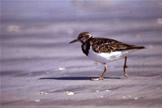 Ruddy Turnstone
Ruddy Turnstone
(Arenaria interpres)
- Stocky, harlequin-patterned shorebird with orange legs
- Russet back and striking black and white pattern in flight
- Named for their feeding method of overturning small stones and seizing the animals hiding underneath.
- Dig large holes in the sand in search of burrowing crustaceans.
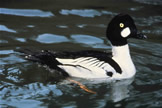 Common Goldeneye
Common Goldeneye
(Bucephala clangula)
- Mostly white diving duck with black back, greenish head (males), and bright yellow eye
- Wings produce loud whistle in flight
- Males provide entertaining courtship display, stretching head forward then snapping it back, bill pointed skyward, while splashing a spray of water out before him.
 Wood Duck
Wood Duck
(Aix sponsa)
- One of the most beautiful ducks in North America
- Males crested, plumage iridescent blues, greens and purples
- Hunted to near extinction in 1800’s, today over 1 million in N.A.
- Nests in tree cavities
- Young will jump from nest to ground or water below
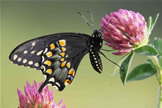 Black Swallowtail
Black Swallowtail
(Papilio polyxenes)
- Attracted to parsley and carrot plants, and nectar sources such as phlox and milkweed.
- Host plant Queen Anne’s Lace
- Chrysalis over-winters
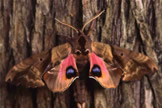 Blind Sphinx Moth
Blind Sphinx Moth
(Paonias excaecatus)
- Wingspan 2 3/8-3 1/8"
- Unlike other members in the sphinx moth family this species has no black center in the blue eyespot - hence "blind"
- Caterpillars feed on apple, birch, and a variety of other trees.
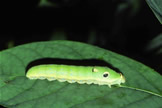 Tiger Swallowtail Caterpillar
Tiger Swallowtail Caterpillar
(Papilio glaucus)
- Young caterpillar brown and white, resembling bird droppings
- Mature caterpillar green with large orange and black false eyespots
- Variety of host plants including cottonwoods, birches, cherries, and tulip-poplars.
- Chrysalis over-winters
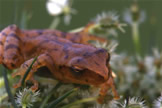 Spring Peeper
Spring Peeper
(Pseudacris crucifer)
- Very small frog (3/4” – 1 3/8”) found in moist wooded habitats
- Identifiable by the dark cross on its back
- Chorus is one of the first signs of spring
- Hibernate under logs and loose bark
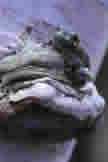 Gray Tree Frog
Gray Tree Frog
(Hyla versicolor)
- Large toe pads aid this aboreal species
- Live high in trees and descend only at night, mainly for breeding
 Common Map Turtle
Common Map Turtle
(Graptemys geographica)
- The most abundant turtle on Presque Isle
- Exhibits extreme sexual dimorphism with adult females being 2-3 times the size of adult males
- Diet consists of aquatic macroinvertebrates: mostly caddis fly larvae in males, mussels including the invasive zebra mussel in females.
- Named for the distinctive map-like pattern on the carapace (top shell)
 Common Snapping Turtle
Common Snapping Turtle
(Cheledra serpentina)
- The largest turtle on Presque Isle, adults can reach 45 pounds!
- The long tail with saw-tooth keels, long claws, and spiny skin give this species a prehistoric look
 Eastern Coyote
Eastern Coyote
(Canis latrans)
- The Coyote’s scientific name means "barking dog" Can run up to 40 mph, the best runner among the canids
- Can make 14-foot leaps
- Runs with its tail down, unlike the domestic dog (tail up) or wolves (tail straight)
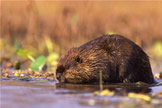 Beaver
Beaver
(Castor canadensis)
- Largest rodent in North America
- Slit nails on inner toes of hind feet used to comb and waterproof fur (by spreading oils)
- Nose, ears, and mouth valves shut when the animal dives
- Lips close behind large front incisors
- Can stay submerged for fifteen minutes
 Yellow Perch
Yellow Perch
(Perca flavescens)
- School near shore, usually at depths less than 30 feet
- Feed morning and evening, and rest on the bottom at night
- Feed year-round – making them a favorite of ice fisherman
 Walleye
Walleye
(Stizostedion vitreum)
- Largest North American species in the perch family
- Highly valued sport and food fish
- Often rest on the lake bottom during the day in shady areas and emerge at dusk to feed.
- Feeds on aquatic insects, crustaceans, amphibians, and fish.
- The largest individual on caught in Lake Erie on record weighed almost 12 pounds
 Rainbow Trout or Steelhead
Rainbow Trout or Steelhead
(Oncorhynchus mykiss)
- Raised for market through aquaculture
- This species migrates into the ocean before returning to spawn in their freshwater home streams
- Stocked Steelhead move and out of the Great Lakes migrate through the lakes much as they would the ocean
- Seldom swim deeper than 35 feet along the Great Lakes shores
 Northern Pike
Northern Pike
(Esox lucius)
- The most widely distributed freshwater fish in the world
- A ravenous predator; consumes three to four times its weight per year
- Diet includes frogs, crayfish, small mammals, and birds
View: Animal Life | Plant Life

 Baltimore Oriole
Baltimore Oriole 





 Rufous-sided or Eastern Towhee
Rufous-sided or Eastern Towhee  Great Horned Owl
Great Horned Owl  Red-headed Woodpecker
Red-headed Woodpecker  Pileated Woodpecker
Pileated Woodpecker  Belted Kingfish
Belted Kingfish  Green Heron
Green Heron  Least Bittern
Least Bittern  Short-billed Dowitcher
Short-billed Dowitcher  Ruddy Turnstone
Ruddy Turnstone  Common Goldeneye
Common Goldeneye  Wood Duck
Wood Duck  Black Swallowtail
Black Swallowtail  Blind Sphinx Moth
Blind Sphinx Moth  Tiger Swallowtail Caterpillar
Tiger Swallowtail Caterpillar  Spring Peeper
Spring Peeper  Gray Tree Frog
Gray Tree Frog  Common Map Turtle
Common Map Turtle  Common Snapping Turtle
Common Snapping Turtle  Eastern Coyote
Eastern Coyote  Beaver
Beaver  Yellow Perch
Yellow Perch  Walleye
Walleye  Rainbow Trout or Steelhead
Rainbow Trout or Steelhead  Northern Pike
Northern Pike 



